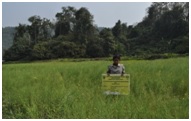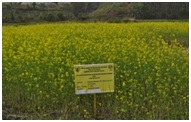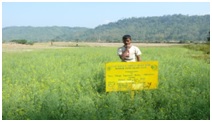Livelihood Improvement of Tribal Farmers of Mizoram through Zero Tillage Rapeseed-Mustard Cultivation in Rice Fallow
Oilseed cultivation is a constraint in Mizoram state, north-east India. The state is having only 2059 ha area under oilseeds with a production 2370 metric tons. Major portion of the area under oilseeds is covered by Kharif oilseeds leaving little scope for increasing area under Rabi oilseeds. The Reason being late harvesting of long duration traditional rice varieties coupled with lack of irrigation facilities. Although expanding area under Rabi oilseeds in upland jhum areas is a constraint, the state is having 15620 ha of land under wetland rice cultivation (WRC) which is highly suitable for the cultivation of Rabi oilseeds like rapeseed-mustard. The advantage for the cultivation of rapeseed-mustard cultivation in the state is short duration of the crop, tolerant to both biotic and abiotic stress and simple package and practices. The introduction of medium duration HYV of rice like Gomati and CAU –R1 in WRC areas of the state is another added advantage for the introduction of rapeseed-mustard in the state.
Recognizing the above facts, ICAR Research Complex for NEH Region, Mizoram Centre evaluated three varieties of rapeseed-mustard; viz M-27, NPJ-113 and P-27 using zero tillage technology under the NICRA programme in collaboration with IARI, New Delhi during Rabi-2012 in the experimental farm, Kolasib . Among the varieties, NPJ-113 recorded a significant higher grain yield in tune of (10.91 q/ha), followed by M-27 (9.41 q/ha) and P-27 (8.24 q/ha) as compared to traditional variety (4.32 q/ha). M-27 because of its high tolerant to water stress is suitable for rainfed areas whereas NPJ-113 and P-27 are suitable for areas where at least two life saving irrigation facilities is available.
Experiencing the success of the varieties in Mizoram state and for mass dissemination of the technology in the state, the Centre had implemented an extension programme, entitled “Zero-tillage Rapeseed Mustard in Rice Fallows for Livelihood Improvement” under Tribal Sub-Plan during Rabi 2013-2015. Two districts, viz. Kolasib and Champhai districts which covered more than 40% of the WRC areas of the state was covered under the programme. Altogether, 100 ha area was demonstrated covering 200 farmers with the zero-tillage technology during the period. A total of 5 training programmes including two field day were organized for acquainting the farmers with the recommended package and practices of the technology. Besides the farmers were also supplied with critical inputs such as seeds, chemical fertilizers and plant protection chemicals. Regular fortnightly monitoring was made by a team of scientists starting from land preparation to harvesting of the crop. During Rabi 2013, when there was a rainfall of 77.4 mm during the crop season, NPJ-113 gave a higher grain yield of (10.01 q/ha), followed by M-27 (9.12 q/ha). However, during Rabi 2014, NPJ-113 recorded the highest grain yield (12.35 q/ha) followed by M-27 (8.81 q/ha). The rainfall during the crop season was meagerly low (15 mm). The average benefit cost ratio of the technology is found to be 2.94.
In all, 300 farmers across the two districts enhanced their income by getting average net return of Rs. 25,000/ha within 105-110 days with a low investment of Rs. 8500/ha. Motivated by the success of the technology, altogether 450 farmers across 10 villages in 5 districts of Mizoram adopted this technology and the area coverage under zero tillage cultivation of rapeseed-mustard increased to 200 ha during Rabi 2015.
The experience of the technology in the farmers’ field indicates that rapeseed-mustard is a climate resilient crop which can be grown without water in the residual soil moisture. By adopting zero tillage, the farmers could increase the productivity, reduced cost of cultivation, increased the cropping intensity and earned an additional income with less effort.
Fig3. Demonstration on zero tillage of rapeseed-mustard under lowland rice fallow at Kolasib and Champhai districts of Mizoram
S. B. Singh, AK. Ratan Singh, T. Boopathi, Y. Ramakrishna, Samik Choudhury, N. Hemanata Singh ICAR Research Complex for NEH Region, Mizoram Centre, Kolasib



